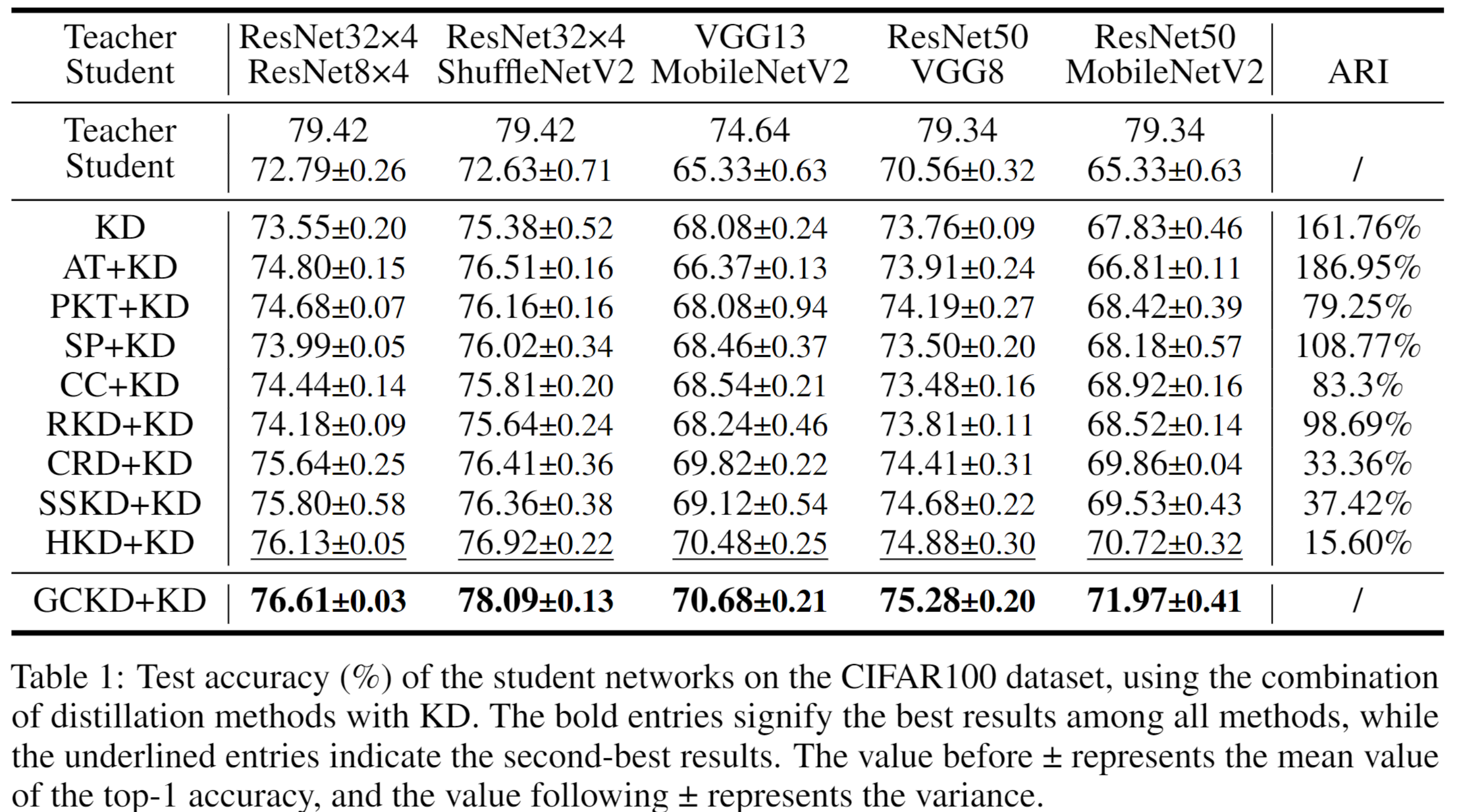This repo contains the Pytorch implementation of Graph Contrastive Knowledge Distillation for Self-supervised Models (GCKD).
The implementation of compared methods are based on the author-provided code and a open-source benchmark https://github.com/HobbitLong/RepDistiller.
Code developed and tested in Python 3.6.15 using PyTorch 1.10.0+cu113 and dgl 1.0.1+cu113. As for ImageNet, we use DALI for data loading and pre-processing. Please refer to their official websites for installation and setup.
Other major requirements are given in file requirements.txt.
conda install --yes --file requirements.txt
-
Fetch the pretrained teacher models by:
sh scripts/fetch_pretrained_teachers.shwhich will download and save the models to
save/teachers/models -
Run distillation by commands in
scripts\run_distill.sh. An example of running GCKD is given by:python train_student.py --path_t ./save/teachers/models/resnet32x4_vanilla/resnet32x4_best.pth --model_s resnet8x4 --distill gckd --last_feature 1 --gnnlayer TAG --layers 2 --gnnencoder one --adj_k 8 --NPerturb 0.1 --EPerturb 0 -c 1 -d 1 -m 1 -b 3 --trial 1
Here's a summary of each hyperparameter in train_student.py
1. Basic:
- `print_freq`: Frequency of printing training progress.
- `batch_size`: Number of samples in each mini-batch.
- `num_workers`: Number of workers to use for data loading.
- `epochs`: Number of training epochs.
- `gpu_id`: ID(s) of the GPU(s) to be used.
2. Optimization:
- `learning_rate`: Learning rate for the optimizer.
- `lr_decay_epochs`: Epochs at which the learning rate should be decayed. It can be a list of values.
- `lr_decay_rate`: Decay rate for the learning rate.
- `weight_decay`: Weight decay (L2 regularization) for the optimizer.
- `momentum`: Momentum value for the optimizer.
- `cos`: Flag indicating whether to use a cosine learning rate schedule.
3. Dataset and Model:
- `dataset`: Dataset to be used ('cifar100' or 'imagenet').
- `model_s`: Student model architecture.
- `path_t`: Path to the teacher model.
4. Distillation:
- `trial`: Trial ID.
- `kd_T`: Temperature for Knowledge Distillation (KD).
- `cl_T`: Temperature for Contrastive Learning (CL) distillation.
- `distill`: Distillation method to be used.
- `cls`: Weight for the classification loss.
- `div`: Weight balance for KD.
- `mu`: Weight balance for feature L2 loss.
- `beta`: Weight balance for other losses.
- `gama`: Weight balance for other losses.
- `factor`: Size factor for SimKD.
- `soft`: Attention scale for SemCKD.
5. Hint Layer:
- `hint_layer`: Index of the hint layer.
6. NCE Distillation:
- `feat_dim`: Feature dimension.
- `mode`: Mode for NCE distillation ('exact' or 'relax').
- `nce_k`: Number of negative samples for Noise Contrastive Estimation (NCE).
- `nce_t`: Temperature parameter for softmax.
- `nce_m`: Momentum for non-parametric updates.
7. GCL (Graph Contrastive Learning):
- `gadv`: Learnable graph augmentation method ('adgcl' or 'None').
- `NPerturb`: Node perturbation rate of graph augmentation.
- `EPerturb`: Edge perturbation rate of graph augmentation.
- `gnnlayer`: Type of Graph Neural Network (GNN) layer.
- `layers`: Depth of GNN layers.
- `last_feature`: The embedding from the last nth layers of the model.
- `gnnencoder`: GNN encoder update method.
- `loss_func`: Form of contrastive loss.
- `adj_k`: k of adjacency matrix.
8. Multiprocessing:
- `dali`: DALI library usage ('cpu' or 'gpu').
- `multiprocessing-distributed`: Flag for multi-processing distributed training.
- `dist-url`: URL used to set up distributed training.
- `deterministic`: Flag for making results reproducible.
- `skip-validation`: Flag for skipping teacher validation.

